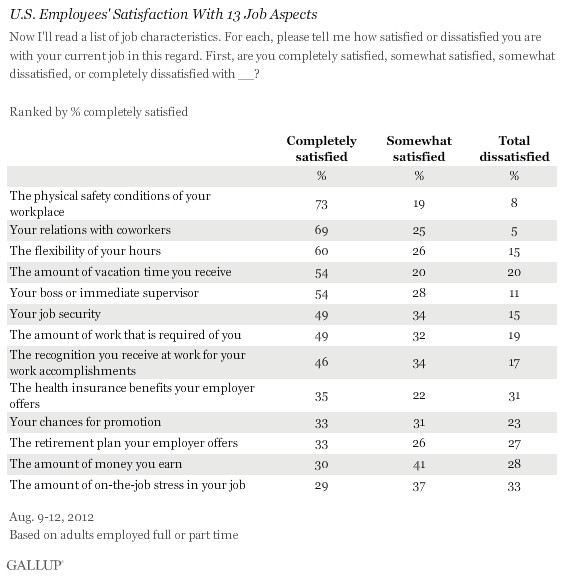- for Associations
- >
- Resources
- >
- How to foster creativity in the workplace
How to foster creativity in the workplace
Many organizations cite that they would like to have a more creative, innovative workplace. However, this discussion cannot be held without giving attention to whether or not employees even like their workplace environment.
Distinguished psychologist and former editor-in-chief for Psychology Today, Dr. Robert Epstein, claims that stress is a creativity killer. A negative workplace climate is inhospitable to risk-taking – ultimately choking out the seeds of creativity.
Gallup prepared a telling poll of how American’s view their workplaces. According to the State of the American Workplace study, more than one-third of Americans feel that they encounter too much “on-the-job-stress.”

However, according to the same study, employee workplace stress has been declining since 2011. These changes show that more employers may be creating recognition benefits and work cultures that help employees cope with a tense and demanding workday.
Recognition for workplace activities has jumped by more than 5 percent from 2011 to 2013, alongside other metrics indicating positive workplace encouragement.
It is important for employers to understand that creativity and recognition for risk-taking work side by side. In order to stimulate creativity, employers must first create a great work place environment where employees are encouraged to contribute.
Given employees are concerned about job security, especially during a time of economic hardship, many fear the consequences of contributing an imperfect idea that might risk their livelihoods. Encouraging and rewarding risk-taking behavior is a way to move employees beyond this fear and start generating fresh new ideas.
Below are tips for encouraging creativity in the workplace:
Eliminate criticism
Alex Osborn, a key partner in the world-famous innovative, advertising agency B.B.D.O., attributed the success of his company to eliminating criticism and negative feedback in group idea-generating sessions. He eloquently wrote in Your Creative Power that, “Creativity is so delicate a flower that praise tends to make it bloom while discouragement often nips it in the bud.” During the team-contribution process, it is a great idea to remember his advice:
“Forget quality; aim now to get a quantity of answers….When you’re through, our sheet of paper may be so full of ridiculous nonsense that you’ll be disgusted. Never mind. You’re loosening up your unfettered imagination – making your mind deliver.”
It is important for managers and team leaders to understand that if participants fear that their statements or contributions might be criticized, they are less likely to participate.
Encourage “brainwriting”
Try encouraging group collaboration via “brainwriting” as supposed to just brainstorming. If one recognizes that their team is more reserved, this is a great way to encourage a smoothly flowing and growing list of ideas. In brainwriting, members write their ideas on paper (or an email) and then pass them on to other members of the group who are required to build on these ideas and add their own contributions. This approach helps reduce the stress of the idea-contribution process and the fear of rejection many people encounter. Also, this contribution method can be done anonymously.
The Houston Chronicle has a great article for teaching staff and co-workers how to manage risk-taking in the workplace, which may also be useful for encouraging risk-adverse employees.
Create a culture that rewards ideas
Employees are encouraged or discouraged by the climate set forth by their co-workers and managers. As a manager or leader in one’s organization, it is important to make sure that one openly encourages new ideas and approaches to problem-solving. Employees often look to their superiors for approval and confirmation on acceptable workplace behavior, therefore congratulating new ideas, no matter how small they may be, is significant. Great managers truly seeking to change their workplaces will reward a great effort, whether it is ultimately successful or not - thus encouraging more innovation.
All rewards for behavior do not necessarily need to be financial. In fact, a complimentary remark, public recognition or positive review may be even more beneficial for changing culture. All people crave positive feedback and the warmth that comes with knowing that they are appreciated and celebrated where they work.
HR World lists a few ideas that are great for rewarding and recognizing employees:
1. Publicize successes – MultiView features a 9th floor Newsletter and Wall of Fame that celebrates leading sales reps. MultiView also announces and celebrates employee successes with standing ovations and office parades.
2. Handwritten congratulations – Taking the time to send a hand-written thank you note is an authentic and sincere way of showing appreciation. Advanced MD CEO, Jim Pack, was especially creative in his delivery. He wrote letters on $2 bills. One can also encourage team members to contribute to the process of writing complimentary and appreciative statements on items like cards, scrapbooks, company t-shirts or photographs.
3. Create workplace-specific trophies – Create a simple trophy unique to one’s company, like a miniature statue that individuals can strive to win. One company leader offered a bouquet of flowers from her home garden and arranged them on employees’ desks. Both men and women competed fiercely for the trophy.
MultiView has a culture that especially encourages risk-taking, creativity and innovation. The company’s new hire guide highlights that employees will always be celebrated for earnestly trying to create solutions to a problem, whether these ideas work or not. Company managers regularly state that if you have a great idea, it can be brought to fruition at MultiView – no matter your role in the company. It is a best practice for other organizations to foster a similarly welcoming attitude towards creativity and innovation.
Success Stories
View testimonials from other associations that share their MultiView success story
Vintage Racing League
National Sherriff's Association
IAEE



